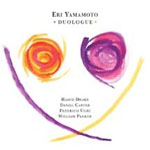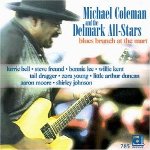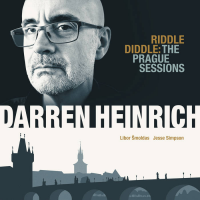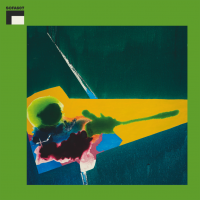Home » Jazz Articles » Album Review » Eri Yamamoto: Duologue
Eri Yamamoto: Duologue
On Duologue, Eri Yamamoto has chosen to play with four musicians whose unique talents are showcased by the way in which she has composed the music. She has taken apart the traditional jazz group ensemble and isolated the parts. She plays a duet with each musician twice, with her playing becoming the common thread that unites them all.
The first and final pieces feature Yamamoto working with drummer Federico Ughi. On "Thank You," two-handed two chord alternation cuts through an invisible membrane of silence to introduce the music. Yamamoto's right hand intercedes with trills and light playful fingering. Ughi responds in kind with taps on the cymbals and trips across the snare drum. The thematic melody emanates in chordal iteration fed by shifting keys, itself portraying the music's mood. Ughi interjects heightened rhythm to correspond with the piano's tempo but mostly paints textures with and in accompaniment to Yamamoto's dedicated fingering. "Your Welcome" feels serious, heavy, and direct. Yamamoto structures the tune with perpetual mid-range chords as Ughi clips the muted snares and reverberates the toms, maintaining a rip-roaring pace with Yamamoto.
The completely interdependent dialog between Daniel Carter and Yamamoto reveals two strong voices which yield to one another in the rise and fall of the sound transformation. It is evident that each is listening to the other intently. Call and response is too simplistic a term to apply to the design of their connectedness because who carries the melody and who is expanding it is always changing.
How William Parker and Yamamoto engage is swept away in the pulse of Parker's bass pizzicato. Responding to the power of Parker's pluck, Yamamoto has no choice but to groove within her own invented theme ("Subway Song"). In "Muse," Yamamoto plays with legato hands, her fingers weighing whole notes as she progresses through the song while Parker's pizzicato instills the piano's simplicity with a blue note yearning.
On "Circular Movement," Yamamoto plugs into the circular rhythm which Hamid Drake employs when playing the frame drum. The timing of the piano's trills, tremolos, and chord placements echos the incessancy of Drake's tapping fingers and palms on the frame drum's skin. A diametrically opposed change in their interaction occurs in "Midtown Blues," where Yamamoto swings with a heavy bass left hand and a swift boogie-woogie right. Drake works hard to keep up with the pianist, his hand hitting the skin more fully to form a broader beat.
A high-end eloquence fills Duologue. Discovering its effusive splendor is worth more than anyone could anticipate.
Track Listing
Thank You; Conversation; Subway Song; Circular Movement; Violet Sky; Midtown Blues; Muse; You Are Welcome.
Personnel
Eri Yamamoto
pianoEri Yamamoto: piano; Daniel Carter: alto saxophone, tenor saxophone; William Parker: bass; Hamid Drake: frame drum; Federico Ughi: drums.
Album information
Title: Duologue | Year Released: 2008 | Record Label: AUM Fidelity
Tags
PREVIOUS / NEXT
Support All About Jazz
 All About Jazz has been a pillar of jazz since 1995, championing it as an art form and, more importantly, supporting the musicians who make it. Our enduring commitment has made "AAJ" one of the most culturally important websites of its kind, read by hundreds of thousands of fans, musicians and industry figures every month.
All About Jazz has been a pillar of jazz since 1995, championing it as an art form and, more importantly, supporting the musicians who make it. Our enduring commitment has made "AAJ" one of the most culturally important websites of its kind, read by hundreds of thousands of fans, musicians and industry figures every month.




















